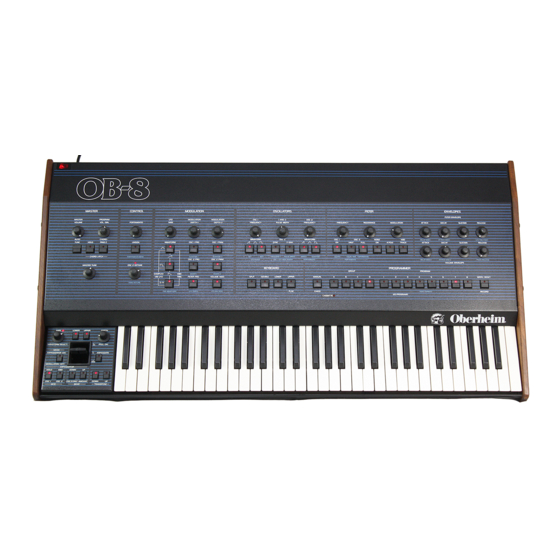
Oberheim ob-8 Instruction Manual
Hide thumbs
Also See for ob-8:
- Owner's manual (76 pages) ,
- Service manual (25 pages) ,
- Instructions (4 pages)
Table of Contents
Advertisement
Quick Links
INTRODUCTION
The 0B-8
is
the
latest development
in
the
evolution
of
Oberheim
synthesizers.
The
design philosophy behind
it
was
to
toke all of the
features of
the OB-Xe, add
as
many new features
as
were economically
feasable, and redesign
oil of the
circuitry
for increased
reliability
and lower cost.
The
result
is a
synthesizer with
90 fewer
calibrations
and
11
less circuit boards, and with many of the remaining
calibrations
microprocessor
assisted.
The
circuitry
and the trimmers
that
were
eliminated have been replaced with software functions
in the
microprocessor which simulate
the replaced hardware.
Some of these
functions
are
explained below.
VCO TRACKING
The volts per octave (scaling) parameters
of the
16
oscillators
in
the
OB-8
are
adjusted by
the
microprocessor whenever
the
AUTO button
is
pressed.
The
processor samples
5
diff eren
t
frequencies
for
each
oscillator and calculates
the
proper correction voltage
to
bring each
oscillator
in tune.
This voltoge changes depending
on the final
pitch
desired from
the
oscillator.
There
is
a
rough trimmer adjustment
for
each
oscillator's
volts per octave
in
order
to get the
oscillator within
the
range
in
which
the
processor can calibrate
it.
If
this
calibration
is
out of the
acceptible range,
it
may be
noticed
by
either AUTO TUNE
failing that oscillator,
or
excessive beating between
it
and other
oscillators while
it is
BETWEEN half
steps.
The reason
for
this
is
that
the
processor compensates
for
scaling
of the
oscillators
for
each half
step,
requiring
that the
oscillator
be
callibrated
well enough
so
that
the
tracking between half steps
is
a
volt per octave.
If
this
is
out of
calibration
it
can also
be
percived
as
steps
in
the
LFO modulation,
since
the
oscillator will jump slightly
in
pitch
as the
modulation
amount reaches each half step.
LFOs
All
of the
LFOs
in
the OB-8 are
generated
in
software.
What this
means
is,
the voltage
necessary
at
any given time to simulate LFO
modulation
is
output through
the DAC
to
whatever destination
is
selected.
If,
for
example,
the
triangle wave
of the
LFO should
be at
its peak,
then
a
high voltage will
be
output
to the
destination.
When
the
LFO should ramp down,
the
voltage
is
decreased.
All of the
electronic switches
and
VCAs normally required
with
a
hardware LFO
in
order
to
determine
its
destination
and
amplitude
are
eliminated since
these
functions
are
now accomplished
in
software.
INTRODUCTION/I
PITCH BEND
The pitch bend and vibrato levers are
scanned
by the
microprocessor
and their relative positions ore calculated
to
determine
the
voltage
necesary
to
bend
a
pitch
up or down, or
how much vibrato
to add.
This
eliminates
all
problems associated with matching
100k
resistors
in
order
to
send equal voltages
to all
voices, op emp offsets, and scaling
trimmers.
There are
2
rough trimmers used
to
bring
the
levers into
range
so that the
processor can
read them.
Once they are
in range, the
processor re-calculates
the
center dead-zone
of
each lever each time
AUTO
is
pressed.
4-POLE FILTER
The
OB-Xa
had
seperate 2-pole
and
4-pole filters
for each voice,
each filter utilizing
a
CEM3320 with different external components
to
implement
the filter
functions.
In
the OB-8, There
is
one 3320 per
voice, and
the
external components
are
electronically switched
to
generate either
a
2-pole
or
a
4-pole slope.
This
eliminates
the
need
to
calibrate
the two
filters seperately, since they are now
the
same
filter.
OP AMP OFFSETS
Many sample
-and
hold
op
amps can affect
a
parameter
if their
offset
is
large.
To
correct
for
this, the
processor uses
a
software
calibration procedure described
later
to
assist
in
setting
the
offset
to
0
volts.
This
adjustment
is
most critical
for the
envelope
time
parameters, since
the
CEM3310 envelope chips require
a
control voltage
range from 0
to 300
millivolts.
The
software
is
able
to
correct
for the
offsets by outputting
a
voltage
to the
sample end holds that will
compensate
for the
offset.
•'
If an op
amp has +30
millivolts
of offset,
the processor. will output 30
millivolts
less than the final
voltage
required
for that
sample and
hold,
effectively canceling
the offset.
Advertisement
Table of Contents















Need help?
Do you have a question about the ob-8 and is the answer not in the manual?
Questions and answers